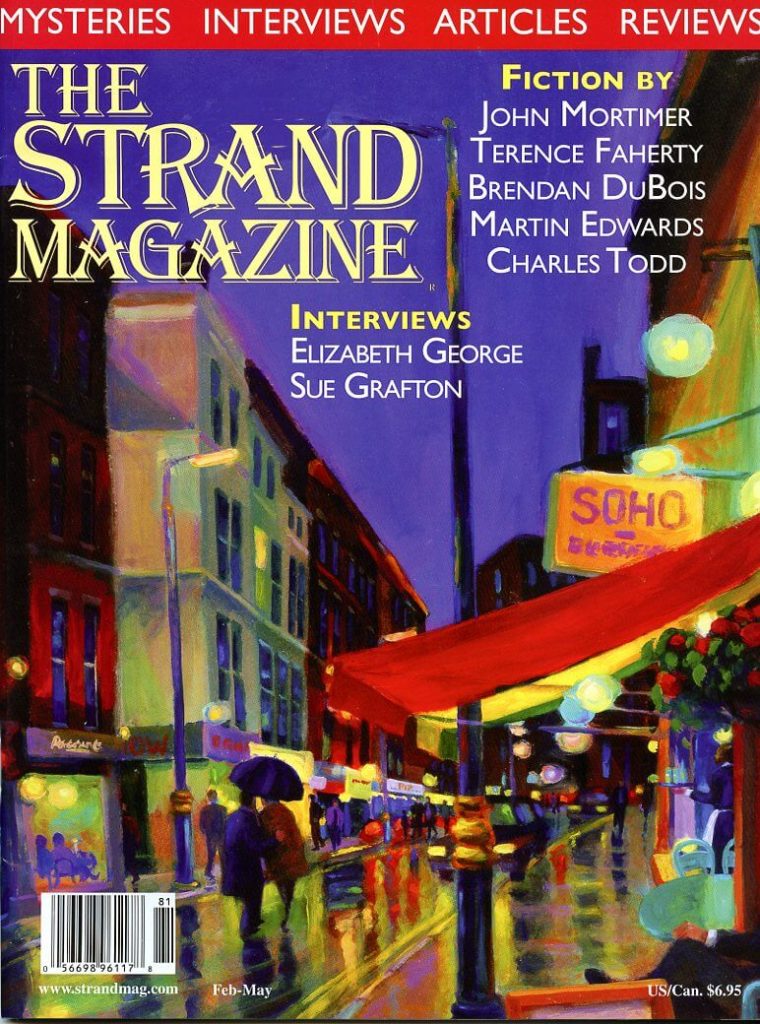Sue Grafton Interview
(EXCERPTS)
(Editor’s Note: This interview with Sue was one of the most entertaining from the standpoint of a reader and an interviewer. Not only was Sue a consummate storyteller and advocate of clean no-nonsense writing, in no time we had a conversation that extended to travel and the search for the best burger in America. Sue will be missed by all and was to the end a class act)
In a writing career that has spanned 25 years, Sue Grafton is certainly no stranger to accolades for her best-selling Kinsey Millhone alphabet mystery series.
In A is for Alibi (1982), Sue Grafton introduced readers to her independent-minded and highly self-sufficient Southern California female private investigator, Kinsey Millhone. Twenty novels later Kinsey is still going strong. As the series has progressed through the alphabet, Kinsey has emerged as a realistic character, who despite her strengths, suffers from her own set of foibles, sensitivities and quirks. Despite the dark nature of her work and her hard-boiled tendencies, she maintains a light-hearted view of life’s problems making her one of the P.I. genre’s most fascinating characters. Through Kinsey’s narrative Grafton has made social commentaries on many of today’s issues, exploring a variety of themes and the motivations behind a broad range of crimes, earning her comparisons to hard-boiled P.I. masters Ross Macdonald and Raymond Chandler.
Sue Grafton was born and raised in Louisville, Kentucky. Her father, C.W. Grafton, was a lawyer and a mystery novelist as well, with four well-received novels to his credit. After graduating from the University of Louisville with a B.A. in English, Sue Grafton held a wide array of jobs before her writing abilities took her to Hollywood, where she began her career as a screenwriter. Her screen credits include Sparkling Cyanide (1983) and A Caribbean Mystery (1983)—both very successful television adaptations of Agatha Christie’s novels of the same names—as well as the chilling thriller, A Killer in the Family (1983), starring Robert Mitchum. After the continual success of the Kinsey Millhone series, and the publication of G is for Gumshoe (1990), Grafton was able to leave her work in Hollywood and become a full-time novelist.
Over the years, the Kinsey Millhone series has won a variety of awards, including Anthony awards for B is for Burglar (1985), C is for Corpse (1986) and G is for Gumshoe (1990). In 1986, Sue and her husband, Steven Humphrey, received an Edgar award nomination from Mystery Writers of America for their television script of Love on the Run. In 1991, she earned an Edgar-award nomination for her short story, “A Poison that Leaves No Trace.” Later this year, Sue Grafton will be the recipient of the highly prestigious Crime Writers Association Diamond Dagger award for her contributions to the mystery genre. She credits a good deal of her success to her subconscious mind, which she refers to as Shadow. Sue Grafton and her husband divide their time between their homes in Santa Barbara, California, and Louisville, Kentucky. Her latest installment in the Kinsey Millhone series, T is for Trespass, was released in December by Penguin Putnam.
AFG: I read T is for Trespass, and I thought it was a fantastic book.
SG: Thank you.
AFG: The big question is, what are you going to do when you run out of alphabet in six novels?
SG: I have a couple of answers for that question, because I get asked that often. It’s been about two years between books of late. Since I have six left, that’s 12 years of work. Add it to my age, which is 67, and I’m gonna be close to 80 by the time I get to Z is for Zero! So I feel it’ll be time for a party! I want some years to kick up my heels! People I know in my age range are all retiring, and taking lovely trips, and visiting their grandchildren, and I’m still sitting here slugging it out with my computer. So I think it will be fun to see what life is bringing me at that point.
AFG: I suggest you use numbers. You start at, 1 is for….
SG: Oh, I will never do linking titles again! If Kinsey Millhone and I have other adventures together, I’ll do standalones and just take care of one book at a time.
AFG: I know you covered a lot of interesting themes in T is for Trespass, like identity theft and mistreatment of the elderly. Could you tell our readers some more about the book?
SG: Well I had a very difficult time coming up with a storyline for T. I had had difficulties with S is for Silence, and then, finally, it occurred to me that I could do multiple points of view and time switches. So what I did was cut back and forth between 1987, when Kinsey is working, to 1953, when Violet Sullivan disappears. And that worked; I was very happy with that solution. When I got to T is for Trespass I thought, “Well, I don’t want to do that again just for the sake of it.” I always let the book tell me what it needs in the way of structure. So instead of stepping in and saying, “I will absolutely impose my will,” I try to back off and keep quiet and let the story dictate the form. So I sat there sweating it out. I came up with six storylines for T, did research on two or three of them, and could not make anything work. This was occurring over a period of 15 months and I was in a panic. I was desperate. With each book I think, “Well that’s my last; I’ve got nothing left in the way of juice!” [laughing] So I became very worried that maybe I’d come to the end of the line, long before the alphabet was ending. I just sat there every day at my computer. It was so unpleasant. There were days when I burst into tears. I told everyone I knew, “It’s over, my career has come to a screeching halt!” Of course, I can’t generate any sympathy because they’ve heard me whine about these things before. [laughing]
AFG: So you always do that!
SG: I do! And they say, “Oh hon, we just know you’ll think of something.” So finally, this little voice in the back of my mind popped up and said, “Would you quit with this? You’ve got six stories. Just pick one and get on with it!” So I just mentally threw a dart at the target and it hit the abuse of the elderly storyline, which made me very uneasy. It seemed like a dark subject, and one that was not exactly designed to cause readers to flock to the bookstores. But I feel at this point that I need to be willing to take risks. I’ve been at this 25 years—this is book 20. If I can’t be vulnerable and put myself on the line then shame on me! So I thought, “Well, for good or for ill, it’s elder abuse,” and I began to fashion that story. And then I had a story that I had deleted from R is for Ricochet. I often have an A story and a B story, and with R is for Ricochet I could see these two stories extending into the future in parallel; I knew they would never cross and that I would have to have two separate climaxes—it would have made no sense at all. So I had stripped that story out of R is for Ricochet and put it in my file. Then, when I was working on T is for Trespass, I was desperate again (I’m always desperate…I feel like the Perils of Pauline). [laughing] I needed to fill pages so that psychologically I could feel like I was advancing and progressing. Shadow—my dark side—said, “Oh, get that story and shove it in here. It’ll plump everything up!” And that’s the story of Melvin Downs and the auto insurance and the accident reconstruction. After I had begun to fold it in, the voice, which again is my shadow, piped up and said to me, “Do you get it, Grafton, why we’re putting these two stories together?” And I said, “No ma’am, I do not.” And she said to me, “Because pedophiles and those who abuse the elderly are both predators. These are just opposite ends of the same continuum of victims.”
AFG: Of hurting the vulnerable.
SG: Yes! So that allowed me to let the stories mirror each other in a curious way, not directly, point by point, but at lea
st I could see the echo of one story in the other.
AFG: Well, you have also talked about identity theft, which I found interesting. I was a victim of identity theft last year—somebody bought almost 600 dollars worth of bathrobes with my card.
SG: Oh no! You know, identity theft has been going on for years, and lately we’ve become much more aware of it. I swear, every other day in the paper there are the six warning signs and the nine suggestions for what you can do to keep yourself safe.

However, the bad guys are still out there making phone calls, claiming to be your bank and wanting to verify all your personal data, and people are still giving out information they have no business giving out.
AFG: Your father was a novelist. Did that help propel you into writing?
SG: Yeah, absolutely. I grew up with parents who adored reading. My father was actually a mystery novelist, and I think it was from him that I developed my passion for this genre. He published in his lifetime three mysteries. Two were part of a projected eight-book series, and there was a standalone called Beyond a Reasonable Doubt. Looking back on it, it seems a teeny-tiny bit dysfunctional, you know, the four of us sitting in a room together reading and not speaking. But it was better than quarreling, I suppose! [laughing] So a love of reading was a major part of my life growing up.
Photo: Laurie Roberts


